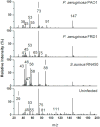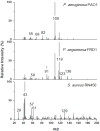Detecting bacterial lung infections: in vivo evaluation of in vitro volatile fingerprints
- PMID: 23307645
- PMCID: PMC4114336
- DOI: 10.1088/1752-7155/7/1/016003
Detecting bacterial lung infections: in vivo evaluation of in vitro volatile fingerprints
Abstract
The identification of bacteria by their volatilomes is of interest to many scientists and clinicians as it holds the promise of diagnosing infections in situ, particularly lung infections via breath analysis. While there are many studies reporting various bacterial volatile biomarkers or fingerprints using in vitro experiments, it has proven difficult to translate these data to in vivo breath analyses. Therefore, we aimed to create secondary electrospray ionization-mass spectrometry (SESI-MS) pathogen fingerprints directly from the breath of mice with lung infections. In this study we demonstrated that SESI-MS is capable of differentiating infected versus uninfected mice, P. aeruginosa-infected versus S. aureus-infected mice, as well as distinguish between infections caused by P. aeruginosa strains PAO1 versus FRD1, with statistical significance (p < 0.05). In addition, we compared in vitro and in vivo volatiles and observed that only 25-34% of peaks are shared between the in vitro and in vivo SESI-MS fingerprints. To the best of our knowledge, these are the first breath volatiles measured for P. aeruginosa PAO1, FRD1, and S. aureus RN450, and the first comparison of in vivo and in vitro volatile profiles from the same strains using the murine infection model.
Figures


Similar articles
-
Robust detection of P. aeruginosa and S. aureus acute lung infections by secondary electrospray ionization-mass spectrometry (SESI-MS) breathprinting: from initial infection to clearance.J Breath Res. 2013 Sep;7(3):037106. doi: 10.1088/1752-7155/7/3/037106. Epub 2013 Jul 18. J Breath Res. 2013. PMID: 23867706 Free PMC article.
-
Breathprints of model murine bacterial lung infections are linked with immune response.Eur Respir J. 2015 Jan;45(1):181-90. doi: 10.1183/09031936.00015814. Epub 2014 Oct 16. Eur Respir J. 2015. PMID: 25323243 Free PMC article.
-
Identifying methicillin-resistant Staphylococcus aureus (MRSA) lung infections in mice via breath analysis using secondary electrospray ionization-mass spectrometry (SESI-MS).J Breath Res. 2014 Oct 13;8(4):041001-41001. doi: 10.1088/1752-7155/8/4/041001. J Breath Res. 2014. PMID: 25307159 Free PMC article.
-
Developments in novel breath tests for bacterial and fungal pulmonary infection.Curr Opin Pulm Med. 2012 May;18(3):228-32. doi: 10.1097/MCP.0b013e328351f98b. Curr Opin Pulm Med. 2012. PMID: 22366996 Review.
-
How to use: bacterial cultures in diagnosing lower respiratory tract infections in cystic fibrosis.Arch Dis Child Educ Pract Ed. 2014 Oct;99(5):181-7. doi: 10.1136/archdischild-2012-303408. Epub 2013 Dec 12. Arch Dis Child Educ Pract Ed. 2014. PMID: 24334311 Review.
Cited by
-
Rapid detection of Staphylococcus aureus and Streptococcus pneumoniae by real-time analysis of volatile metabolites.iScience. 2022 Sep 6;25(10):105080. doi: 10.1016/j.isci.2022.105080. eCollection 2022 Oct 21. iScience. 2022. PMID: 36157573 Free PMC article.
-
Predominant SARS-CoV-2 variant impacts accuracy when screening for infection using exhaled breath vapor.Commun Med (Lond). 2022 Dec 8;2(1):158. doi: 10.1038/s43856-022-00221-5. Commun Med (Lond). 2022. PMID: 36482179 Free PMC article.
-
Volatile Metabolites in Lavage Fluid Are Correlated with Cytokine Production in a Valley Fever Murine Model.J Fungi (Basel). 2023 Jan 14;9(1):115. doi: 10.3390/jof9010115. J Fungi (Basel). 2023. PMID: 36675936 Free PMC article.
-
Current Limitations of Staph Infection Diagnostics, and the Role for VOCs in Achieving Culture-Independent Detection.Pathogens. 2023 Jan 24;12(2):181. doi: 10.3390/pathogens12020181. Pathogens. 2023. PMID: 36839453 Free PMC article. Review.
-
Volatilomes of Bacterial Infections in Humans.Front Neurosci. 2020 Mar 25;14:257. doi: 10.3389/fnins.2020.00257. eCollection 2020. Front Neurosci. 2020. PMID: 32269511 Free PMC article. Review.
References
-
- Casalinuovo I, Di Pierro D, Coletta M, Di Francesco P. Application of electronic noses for disease diagnosis and food spoilage detection. Sensors. 2006;6:1428–39.
-
- Ulanowska A, Kowalkowski T, Hrynkiewicz K, Jackowski M, Buszewski B. Determination of volatile organic compounds in human breath for Helicobacter pylori detection by SPME-GC/MS. Biomed Chromatogr. 2011;25:391–7. - PubMed
Publication types
MeSH terms
Substances
Grants and funding
LinkOut - more resources
Full Text Sources
Other Literature Sources
